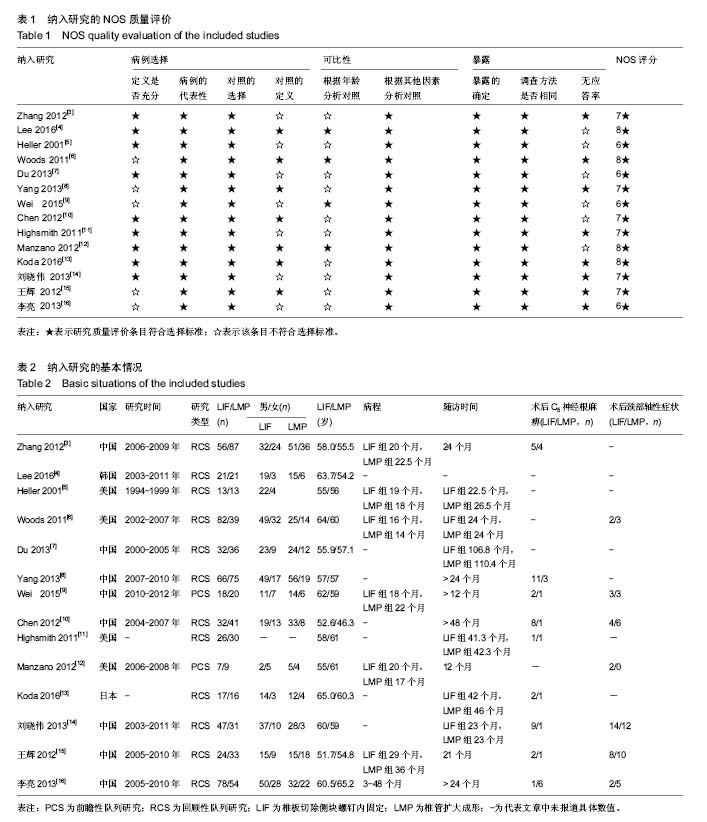Chinese Journal of Tissue Engineering Research ›› 2017, Vol. 21 ›› Issue (3): 485-492.doi: 10.3969/j.issn.2095-4344.2017.03.028
Meta-analysis of posterior laminectomy and instrumented fusion versus laminoplasty in treatment of multilevel cervical spondylotic myelopathy
Zha Yuan-yu, Yang Yang, Chen Shu-zhen, Wei Ren-xiong, Zhang Shu-wei, Jin Wei
- Department of Orthopedics, Zhongnan Hospital of Wuhan University, Wuhan 430071, Hubei Province, China
-
Online:2017-01-28Published:2017-03-14 -
Contact:Jin Wei, M.D., Associate professor, Department of Orthopedics, Zhongnan Hospital of Wuhan University, Wuhan 430071, Hubei Province, China -
About author:Zha Yuan-yu, Studying for master’s degree, Department of Orthopedics, Zhongnan Hospital of Wuhan University, Wuhan 430071, Hubei Province, China
CLC Number:
Cite this article
Zha Yuan-yu, Yang Yang, Chen Shu-zhen, Wei Ren-xiong, Zhang Shu-wei, Jin Wei. Meta-analysis of posterior laminectomy and instrumented fusion versus laminoplasty in treatment of multilevel cervical spondylotic myelopathy[J]. Chinese Journal of Tissue Engineering Research, 2017, 21(3): 485-492.
share this article
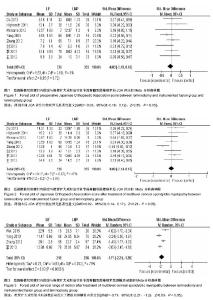
2.2 Meta分析结果 2.2.1 术前JOA评分 8篇文献报道了术前JOA评分情 况[3,7-8,11-12,14-16],各研究间无异质性(P > 0.05,I2=0),采用固定效应模型。Meta分析结果显示,两组术前JOA评分比较差异无显著性意义[SMD=-0.03,95%CI (-0.18,0.12),Z=0.35,P > 0.05],见图1,提示两组术前神经功能情况相似。 2.2.2 术后JOA评分 8篇文献报道了术后JOA评分情 况[3,7-8,11-12,14-16],各研究间无异质性(P > 0.05,I2=47%),采用固定效应模型。Meta分析结果显示,两组术后JOA评分比较差异无显著性意义[SMD=0.02,95%CI(-0.14,0.17),Z=0.21,P > 0.05],见图2,提示两组术后神经功能情况相似。 2.2.3 术后颈椎活动度 4篇文献报道了术后颈椎活动度情况[3,8-9,16],各研究间存在异质性(P < 0.05,I2=79%),采用随机效应模型。Meta分析结果显示,LMP组术后颈椎活动度大于LIF组[SMD=-0.71,95%CI (-2.21,-1.2),Z=6.63,P<0.05],见图3;敏感性分析发现分别剔除各项研究,合并效应量仍都有统计学意义且森林图结果方向均未发生改变。"
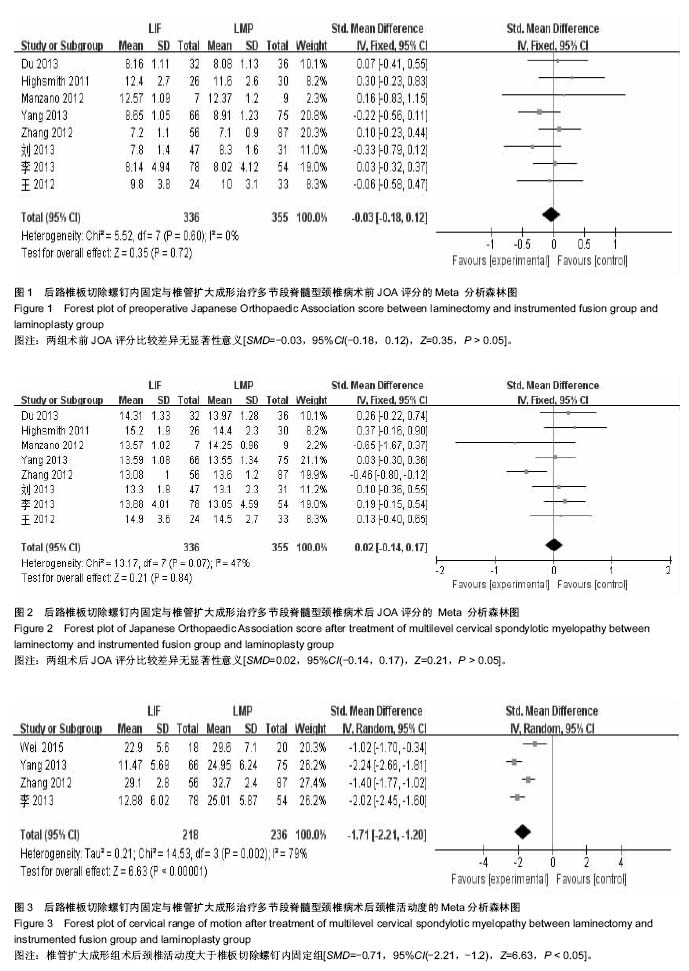
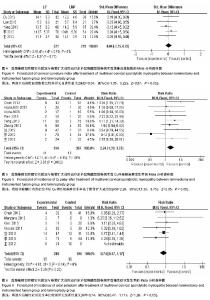
2.2.4 术后颈椎曲度指数 5篇文献报道了术后颈椎曲度指数情况[4,7-8,15-16],各研究间无异质性(P > 0.05,I2= 0),采用固定效应模型。Meta分析结果显示,两组术后颈椎曲度指数比较差异无显著性意义[SMD=0.04,95%CI(-1.05,0.22),Z=0.37,P>0.05],见图4,提示两组术后颈椎曲度情况相似。 2.2.5 术后C5神经根麻痹发生率 9篇文献报道了术后C5神经根麻痹发生率情况[3,8-11,13-16],各研究间无异质性(P > 0.05,I2=34%),采用固定效应模型。Meta分析结果显示,LIF组术后C5神经根麻痹发生率高于LMP组[RR=2.24,95%CI(1.33,3.75),Z=3.05,P < 0.05],见图5。 2.2.6 术后轴性症状发生率 7篇文献报道了术后轴性症状发生率情况[6,9-10,12,14-16],各研究间无异质性(P > 0.05,I2=0),采用固定效应模型。Meta分析结果显示,两组患者术后轴性症状发生率比较差异无显著性意义[RR=0.74,95%CI(0.47,1.17),Z=1.29,P > 0.05],见图6,提示两种手术患者术后轴性症状发生率相似。 2.2.7 发表偏倚 共纳入14篇文献,术前JOA评分、术后JOA评分、术后颈椎曲度指数、术后C5神经根麻痹发生率、术后轴性症状发生率5个指标的漏斗图集中在图形上部,左右基本对称,表明存在发表偏倚的可能性较小。术后颈椎活动度指标漏斗图非对称,表明存在相关发表偏倚。尽管如此,进行敏感性分析时对各项研究依次剔除1次,剩余研究进行合并分析,仍都具有统计学意义且森林图结果方向均未发生改变。"
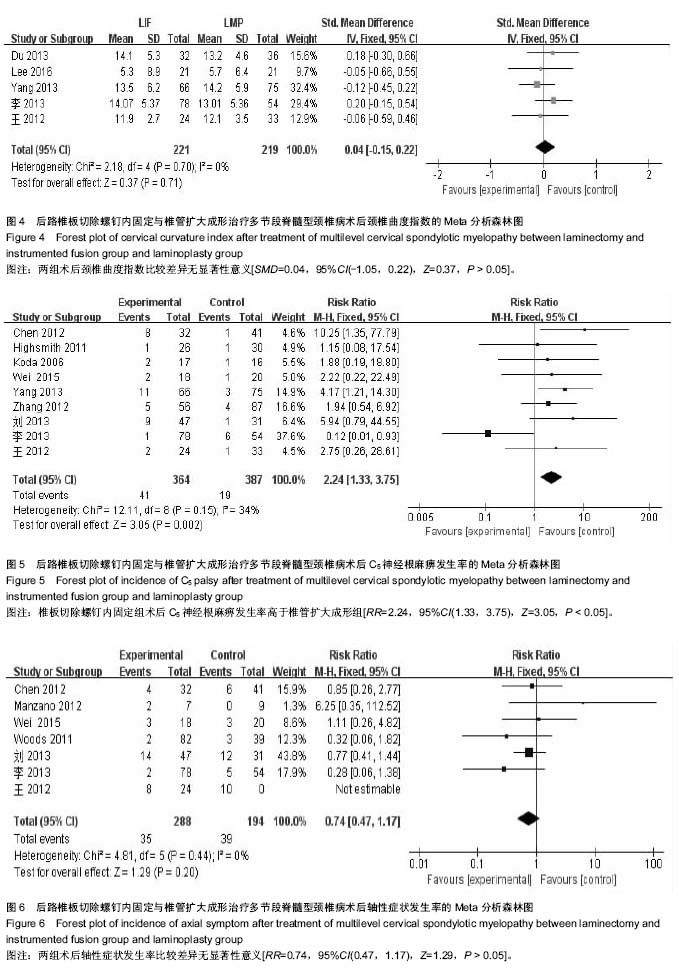
| [1] Karadimas SK,Gatzounis G,Fehlings MG.Pathobiology of cervical spondylotic myelopathy.Eur Spine J.2015;24(2): 132-138. [2] Wells GA,Shea BJ,O'Connell D,et al.The Newcastle- Ottawa Scale (NOS) for assessing the quality of nonrandomized studies in meta-analyses. Appl Eng Agric. 2002;18(6):727-734.[3] Zhang H,Sun T,Shouliang LU,et al.Comparison of effectiveness between laminoplasty and laminectomy decompression and fusion with internal fixation for cervical spondylotic myelopathy. Zhongguo Xiu Fu Chong Jian Wai Ke Za Zhi. 2012;26(10):1191-1196.[4] Lee CH,Jahng TA,Hyun SJ,et al.Expansive Laminoplasty Versus Laminectomy Alone Versus Laminectomy and Fusion for Cervical Ossification of the Posterior Longitudinal Ligament: Is There a Difference in the Clinical Outcome and Sagittal Alignment? Clin Spine Surg.2016; 29(1):E9-15.[5] Heller JG,Murakami H,Rodts GE.Laminoplasty versus laminectomy and fusion for multilevel cervical myelopathy: an independent matched cohort analysis.Spine(Phila Pa 1976). 2001;26(12): 1330-1336.[6] Woods BI,Hohl J,Lee J,et al.Laminoplasty versus Laminectomy and Fusion for Multilevel Cervical Spondylotic Myelopathy.Clin Orthop Relat Res.2011; 469(3):688-695.[7] Du W,Wang L,Shen Y,et al.Long-term impacts of different posterior operations on curvature, neurological recovery and axial symptoms for multilevel cervical degenerative myelopathy.Eur Spine J.2013;22(7):1594-1602.[8] Yang L,Gu Y,Shi J,et al. Modified Plate-only Open-door Laminoplasty Versus Laminectomy and Fusion for the Treatment of Cervical Stenotic Myelopathy. Orthopedics. 2013;36(36):e79-87.[9] Wei Y,Yue Z,Liu X,et al.Postoperative three-dimensional cervical range of motion and neurological outcomes in patients with cervical ossification of the posterior longitudinal ligament: Cervical laminoplasty versus laminectomy with fusion.Clin Neurol Neurosurg.2015; 134:17-23.[10] Chen Y,Liu X,Chen D,et al.Surgical strategy for ossification of the posterior longitudinal ligament in the cervical spine. Orthopedics.2012;35(8): 1231-1237.[11] Highsmith JM,Dhall SS,Haid RW,et al.Treatment of cervical stenotic myelopathy: a cost and, outcome comparison of laminoplasty versus laminectomy, and lateral mass fusion.J Neurosurg Spine.2011;14(5):619-625.[12] Manzano GR,Casella G,Wang MY,et al.A prospective, randomized trial comparing expansile cervical laminoplasty and cervical laminectomy and fusion for multilevel cervical myelopathy.Neurosurgery.2012;70(2):264-277.[13] Koda M,Mochizuki M,Konishi H,et al.Comparison of clinical outcomes between laminoplasty, posterior decompression with instrumented fusion, and anterior decompression with fusion for K-line (–) cervical ossification of the posterior longitudinal ligament.Eur Spine J.2016;25(7):2294-2301.[14] 刘晓伟,陈德玉,王新伟,等.颈椎后纵韧带骨化症患者K线对两种颈后路手术疗效的影响[J].中国脊柱脊髓杂志,2013, 23(1): 6-10.[15] 王辉,丁文元,申勇,等.颈椎后纵韧带骨化症间接减压术后轴性症状分析[J].中华外科杂志,2012,50(7):601-606[16] 李亮,燕树义,于学忠,等.两种颈后路术式对颈椎曲度及椎间高度的中期影响[J].中国矫形外科杂志,2013,21(19): 1929-1936.[17] Yukawa Y,Kato F,Ito K,et al.Laminoplasty and skip laminectomy for cervical compressive myelopathy: range of motion, postoperative neck pain, and surgical outcomes in a randomized prospective study.Spine(Phila Pa 1976).2007; 32(18):1980-1985.[18] Park YS,Nakase H,Kawaguchi S,et al.Predictors of outcome of surgery for cervical compressive myelopathy: retrospective analysis and prospective study.Neurol Med Chir.2006;46(5):231-238.[19] 侯增涛,赵爱琳,郭传友,等.多节段脊髓型颈椎病治疗方式选择与疗效评价[J].中国组织工程研究,2014,18(40): 6444-6450.[20] 胡孔和,吴强,靳安民,等.颈椎单开门OsteoMed M3钉板内固定椎管扩大成形术螺钉进钉点的解剖学CT测量[J].中国矫形外科杂志,2012,20(24):2272-2275.[21] 安忠诚,曹瑞,盛伟斌,等.保留双侧半棘肌改良单开门椎管扩大钢板置入:减少轴性症状及颈椎曲度丢失[J].中国组织工程研究,2016,20(13):1873-1879.[22] Kim B,Yoon DH,Shin HC,et al.Surgical outcome and prognostic factors of anterior decompression and fusion for cervical compressive myelopathy due to ossification of the posterior longitudinal ligament.Spine J.2015;15(5):875-884.[23] 翟吉良,翁习生,胡建华.颈椎减压术后C5神经根麻痹的研究进展[J].中国脊柱脊髓杂志,2014,24(1):73-76.[24] 王新伟,袁文,陈德玉,等.颈椎后纵韧带骨化症的手术方式选择及疗效[J].中华外科杂志,2012,50(7):596-600.[25] 周非非,孙宇,张凤山,等.颈椎前路椎间盘切除、植骨融合内固定术治疗脊髓型颈椎病术后轴性症状的前瞻性研究[J].中国脊柱脊髓杂志,2014,24(6):505-509.[26] Sakaura H,Hosono N,Mukai Y,et al.Preservation of muscles attached to the C2 and C7 spinous processes rather than subaxial deep extensors reduces adverse effects after cervical laminoplasty.Spine(Phila Pa 1976).2010;35(35): 782-786.[27] 张为,李鹏飞,申勇,等.颈后路三种手术方法对颈椎曲度及轴性症状的长期影响[J].中国矫形外科杂志, 2011,19(9):709-712.[28] Schulz KF,Moher D,Altman DG.CONSORT 2010 comments.Lancet.2010; 376(9748):1222-1223. |
| [1] | Shi Bin, An Jing, Chen Long-gang, Zhang Nan, Tian Ye . Influencing factors for pain after total knee arthroplasty [J]. Chinese Journal of Tissue Engineering Research, 2017, 21(7): 993-997. |
| [2] | Wang Xian-xun. Impact of local compression cryotherapy combined with continuous passive motion on the early functional recovery after total knee arthroplasty [J]. Chinese Journal of Tissue Engineering Research, 2017, 21(7): 998-1003. |
| [3] | Yuan Wei, Zhao Hui, Ding Zhe-ru, Wu Yu-li, Wu Hai-shan, Qian Qi-rong. Association between psychological resilience and acute mental disorders after total knee arthroplasty [J]. Chinese Journal of Tissue Engineering Research, 2017, 21(7): 1015-1019. |
| [4] | Chen Qun-qun, Qiao Rong-qin, Duan Rui-qi, Hu Nian-hong, Li Zhao, Shao Min. Acu-Loc®2 volar distal radius bone plate system for repairing type C fracture of distal radius [J]. Chinese Journal of Tissue Engineering Research, 2017, 21(7): 1025-1030. |
| [5] | Huang Xiang-wang, Liu Hong-zhe. A new low elastic modulus of beta titanium alloy Ti2448 spinal pedicle screw fixation affects thoracic stability: biomechanical analysis [J]. Chinese Journal of Tissue Engineering Research, 2017, 21(7): 1031-1035. |
| [6] | Xie Qiang. Three-dimensional finite element model for biomechanical analysis of stress in knee inversion and external rotation after posterior cruciate ligament rupture [J]. Chinese Journal of Tissue Engineering Research, 2017, 21(7): 1036-1040. |
| [7] | He Ze-dong, Zhao Jing, Chen Liang-yu, Li Ke, Weng Jie. Multilevel finite element analysis on the biological tribology damage of water on bone tissue [J]. Chinese Journal of Tissue Engineering Research, 2017, 21(7): 1041-1045. |
| [8] | Jiang Zi-wei, Huang Feng, Cheng Si-yuan, Zheng Xiao-hui, Sun Shi-dong, Zhao Jing-tao, Cong Hai-chen,Sun Han-qiao, Dong Hang. Design and finite element analysis of digital splint [J]. Chinese Journal of Tissue Engineering Research, 2017, 21(7): 1052-1056. |
| [9] | Wang Fei, Liu Zhi-bin, Tao Hui-ren, Zhang Jian-hua, Li Chang-hong, Cao Qiang, Zheng Jun, Liu Yan-xiong, Qu Xiao-peng. Clinical efficacy of preoperative osteotomy designs using paper-cut technology versus photoshop software for ankylosing spondylitis with kyphosis [J]. Chinese Journal of Tissue Engineering Research, 2017, 21(7): 1057-1063. |
| [10] | Li Hui, Ma Jun-yi, Ma Yuan, Zhu Xu . Establishment of a three-dimensional finite element model of ankylosing spondylitis kyphosis [J]. Chinese Journal of Tissue Engineering Research, 2017, 21(7): 1069-1073. |
| [11] | Ling Guan-han, Ou Zhi-xue, Yao Lan, Wen Li-chun, Wang Guo-xiang, Lin Heng-feng. Establishment of simulating three-dimensional model of China-Japan Friendship Hospital Classification for L type osteonecrosis of the femoral head [J]. Chinese Journal of Tissue Engineering Research, 2017, 21(7): 1074-1079. |
| [12] | Fu Wei-min, Wang Ben-jie. Assessing the degree of necrotic femoral head, and association of blood supply with pathlogical changes: study protocol for a diagnostic animal trial [J]. Chinese Journal of Tissue Engineering Research, 2017, 21(7): 1086-1091. |
| [13] | Zhang Wen-qiang, Ding Qian, Zhang Na. Associations between alpha angle and herniation pit on oblique axial magnetic resonance imaging in asymptomatic hip joints of adults [J]. Chinese Journal of Tissue Engineering Research, 2017, 21(7): 1098-1103. |
| [14] | Sun Xiao-xin1, Zhou Wei2, Zuo Shu-ping3, Liu Hao1, Song Jing-feng1, Liang Chun-yu1. Morphological characteristics for the magnetic resonance imaging assessment of discoid lateral meniscal tears in children [J]. Chinese Journal of Tissue Engineering Research, 2017, 21(7): 1104-1109. |
| [15] | Lin Han-wen, Wen Jun-mao, Huang Chao-yuan, Zhou Chi, Tang Hong-yu. Correlation between the changes in lower limb power line and pain area in the knee osteoarthritis patients: imaging evaluation [J]. Chinese Journal of Tissue Engineering Research, 2017, 21(7): 1110-1114. |
| Viewed | ||||||
|
Full text |
|
|||||
|
Abstract |
|
|||||

